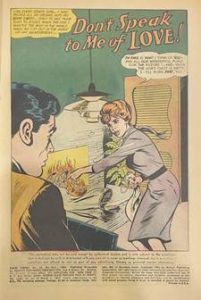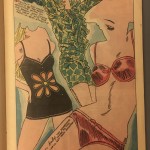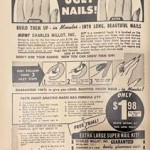Enjoy this post by Ten Nazur, one of our Special Collections Freshman Fellows for the 2021-2022 academic year!
Hey, everyone! My name is Ten Nazur, a Freshman Fellow filled with funky opinions and offbeat ideas cultivated through years of severe nerdom and video essays! I’ll be guiding you through my research so far on mid-20th century romance comic books. There’s much more to come but we have to start somewhere.
Now—Americans are obsessed with Good Art. The award winners, the carried down classics, the always and ever compelling miniseries: these are what drive a lot of our tastes and a lot of our cultural consumption. In Good Art, there’s so much to analyze, to praise, to dissect. That’s the appeal of it after all. It’s beautiful and respectable and reflective and a million other flattering phrases. But they don’t really matter in the end.
Real value, I believe, lies in things that aren’t good—maybe they’re just mediocre or maybe they’re straight up bad. It doesn’t truly matter so long as they aren’t a part of that Good Art.

Mediocre stories just reveal so much. Like those vintage plastic cased Gameboys, a mediocre story invites you into the innards of the work itself, each facet functioning like a soldered connection on a circuit board. All the little things that inform a writer’s world view and contribute to the story as a whole bubble up to the surface—unconscious biases, convictions of creativity under censorship, undercurrents of subtle racism, perspectives of the Other.
They’re messy. They’re honest. They are not at all subtle. These comics—Girl’s Romance, Young Love, Secret Hearts; the title doesn’t matter nearly as much as the comic itself—fall into that revealing “Not Good” category.
That’s what makes them so interesting, so compelling!
They create an unfiltered look into the past, unclouded by the desire to create something long lasting and perfect. They reflect the everyday values and interests of normal people (and teenage girls at that!) in such a personal way, almost like a postcard to a far-flung family member.
Though the stories are formulaic and characters ever familiar, discovery awaits. All the mess of mediocrity remains within these comics, sparking thousands of new questions about such a broad range of topics; censorship, advertising, concepts of love, enforcement of gender roles, just to scratch the surface.
The advertisements alone are such an important visual for the shifting culture of America. Everything now—clothing, colors, and weirdly enough body types—seem to fall in and out of fashion within months but the changes throughout the decades move slowly and distinctly. Each decade values female skinniness more and more, with weight loss ads popping up and weight gain ads fading away. But there were also ads for teen boys in these comics too, specifically for weight gain! Not to even begin on the truly obsessive pushing of beauty products in these comics, with one specific nail kit being featured in almost every single comic in our collection past 1965. (If that doesn’t sound like a lot, I promise that it is. While I’m not too into math, I’ve run the numbers and that’s roughly 65% of our collection.)
The ideal body type in most of the Collection’s comics and the ever-present nail kit- the print equivalent of the ads in front of YouTube videos. Source: Falling in Love #99 circa 1968/Girls Romance’s #158, circa 1971.

Though it creates an immense niche for the analysis of social gender conditioning and beauty ideals, the ads in these comics weren’t just about beauty products and weight monitoring—they were diverse. They were eccentric and hit every demographic audience that existed. There were ads for celebrity fan clubs, universities, fishing sets, proto-photo cards, multilevel marketing schemes, action comics, and insane knickknacks and toys like Dawk™, a weird yarn ball with feet. (He’s my favorite little guy.)
The ads are kooky but the plots line are common enough. Throughout the dozens of comics I’ve read so far, I’ve noticed a common thread. Love is perceived as something that is stumbled upon, something that blooms at just the right moment. It’s a wild dramatic moment, a feeling that somehow creates enough momentum to last a lifetime. There’s no choice. There’s no work involved. It just is.
The mediocrity of it is astounding and phenomenal in the same breath. Sure, these are campy escapist stories but I love making things more complicated. There’s nothing like digging deeper than necessary, analyzing a story beyond the point of saving. Messy stories are just so much more enjoyable and genuine. They leave so much space for understanding and examination.
They’re not “Good Art” but that makes them all the better. Not everything in life is perfect or easy, and though these try to say otherwise (at least within the sphere of romance), they truly show the complexity of the time in which they were created. It was a rapidly changing world in the 20th century, and we still carry that momentum in the 21st century. There really isn’t that much of a difference between the past and now but we still have to put together the pieces in order to truly understand how.



